In 1943, production of the V-2 rocket began in Germany. It had an operational range of 300 km
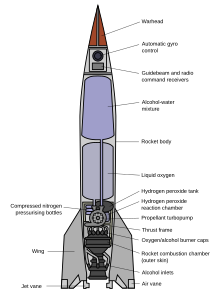
(190 mi) and carried a 1,000 kg (2,200 lb) warhead, with an amatol explosive charge. It normally achieved an operational maximum altitude of around 90 km (56 mi), but could achieve 206 km (128 mi) if launched vertically. The vehicle was similar to most modern rockets, with

turbopumps, inertial guidance and many other features. Thousands were fired at various Allied nations, mainly Belgium, as well as England and France. While they could not be intercepted, their guidance system design and single conventional warhead meant that it was insufficiently accurate against military targets. A total of 2,754 people in England were killed, and 6,523 were wounded before the launch campaign was ended. There were also 20,000 deaths of slave labour during the construction of V-2s. While it did not significantly affect the course of the war, the V-2 provided a lethal demonstration of the potential for guided rockets as weapons.
In parallel with the guided missile programme in Nazi Germany, rockets were also used on aircraft, either for assisting horizontal take-off (JATO), vertical take-off (Bachem Ba 349 "Natter") or for powering them (Me 163,[42] etc.). During the war Germany also developed several guided and unguided air-to-air, ground-to-air and ground-to-ground missiles (see list of World War II guided missiles of Germany).
The Allies rocket programms were much less sophisticated, relying mostly on unguided missiles like the Soviet Katyusha rocket.
Post World War II

At the end of World War II, competing Russian, British, and US military and scientific crews raced to capture technology and trained personnel from the German rocket program at Peenemünde. Russia and Britain had some success, but the United States benefited the most. The US captured a large number of German rocket scientists (many of whom were members of the Nazi Party, including von Braun) and brought them to the United States as part of Operation Overcast.[43] In America, the same rockets that were designed to rain down on Britain were used instead by scientists as research vehicles for developing the new technology further. The V-2 evolved into the American Redstone rocket, used in the early space program.
After the war, rockets were used to study high-altitude conditions, by radio telemetry of temperature and pressure of the atmosphere, detection of cosmic rays, and further research; notably for the Bell X-1 to break the sound barrier. This continued in the US under von Braun and the others, who were destined to become part of the US scientific complex.
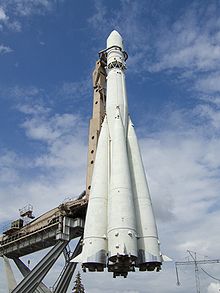
Independently, in the Soviet Union's space program research continued under the leadership of the chief designer Sergei Korolev.[45] With the help of German technicians, the V-2 was duplicated and improved as the R-1, R-2 and R-5 missiles. German designs were abandoned in the late 1940s, and the foreign workers were sent home. A new series of engines built by Glushko and based on inventions of Aleksei Mihailovich Isaev formed the basis of the first ICBM, the R-7.The R-7 launched the first satellite- Sputnik 1, and later Yuri Gagarin-the first man into space, and the first lunar and planetary probes. This rocket is still in use today. These prestigious events attracted the attention of top politicians, along with additional funds for further research.
One problem that had not been solved was atmospheric reentry. It had been shown that an orbital vehicle easily had enough kinetic energy to vaporize itself, and yet it was known that meteorites can make it down to the ground. The mystery was solved in the US in 1951 when H. Julian Allen and A. J. Eggers, Jr. of the National Advisory Committee for Aeronautics (NACA) made the counterintuitive discovery that a blunt shape (high drag) permitted the most effective heat shield. With this type of shape, around 99% of the energy goes into the air rather than vehicle, and this permitted safe recovery of orbital vehicles.

The Allen and Eggers discovery, though initially treated as a military secret, was eventually published in 1958.[48] The Blunt Body Theory made possible the heat shield designs that were embodied in the Mercury and all other space capsules and space planes, enabling astronauts to survive the fiery re-entry into Earth's atmosphere.
Cold war
Rockets became extremely important militarily as modern intercontinental ballistic missiles (ICBMs) when it was realized that nuclear weapons carried on a rocket vehicle were essentially not defensible against once launched, and ICBM/Launch vehicles such as the R-7, Atlas and Titan became the delivery platform of choice for these weapons.

Fueled partly by the Cold War, the 1960s became the decade of rapid development of rocket technology particularly in the Soviet Union (Vostok, Soyuz, Proton) and in the United States (e.g. the X-15[49] and X-20 Dyna-Soar[50] aircraft). There was also significant research in other countries, such as Britain, Japan, Australia, etc., and their growing use for Space exploration, with pictures returned from the far side of the Moon and unmanned flights for Mars exploration.
In America the manned programmes, Project Mercury, Project Gemini and later the Apollo programme culminated in 1969 with the first manned landing on the moon via the Saturn V, causing the New York Times to retract their earlier editorial implying that spaceflight couldn't work:
| “ | Further investigation and experimentation have confirmed the findings of Isaac Newton in the 17th century and it is now definitely established that a rocket can function in a vacuum as well as in an atmosphere. The Times regrets the error. | ” |
| —New York Times, 17 June 1969 - A Correction | ||
In the 1970s America made further lunar landings, before cancelling the Apollo programme. The replacement vehicle, the partially reusable 'Space Shuttle' was intended to be cheaper, but this large reduction in costs was largely not achieved. Meanwhile in 1973, the expendable Ariane programme was begun, a launcher that by the year 2000 would capture much of the geosat market.
Current day
Rockets remain a popular military weapon. The use of large battlefield rockets of the V-2 type has given way to guided missiles. However rockets are often used by helicopters and light aircraft for ground attack, being more powerful than machine guns, but without the recoil of a heavy cannon and by the early 1960s air-to-air missiles became favoured. Current artillery systems as MLRS or Smerch launch multiple rockets to saturate battlefield targets with munitions.[citation needed]

Economically, rocketry is the enabler of all space technologies particularly satellites, many of which impact people's everyday lives in almost countless ways.
Scientifically, rocketry has opened a window on the universe, allowing the launch of space probes to explore the solar system and space-based telescopes to obtain a clearer view of the rest of the universe.
However, it is probably manned spaceflight that has predominantly caught the imagination of the public. Vehicles such as the Space Shuttle for scientific research, the Soyuz increasingly for orbital tourism and SpaceShipOne for suborbital tourism may show a trend towards greater commercialisation of manned rocketry.
Types
- Vehicle configurations

Rocket vehicles are often constructed in the archetypal tall thin "rocket" shape that takes off vertically, but there are actually many different types of rockets including
- tiny models such as balloon rockets, water rockets, skyrockets or small solid rockets that can be purchased at a hobby store
- missiles
- space rockets such as the enormous Saturn V used for the Apollo program
- rocket cars
- rocket bike
- rocket powered aircraft (including rocket assisted takeoff of conventional aircraft- JATO)
- rocket sleds
- rocket trains
- rocket torpedos[58][59]
- rocket powered jet packs[60]
- rapid escape systems such as ejection seats and launch escape systems
- space probes
Design
A rocket design can be as simple as a cardboard tube filled with black powder, but to make an efficient, accurate rocket or missile involves overcoming a number of difficult problems. The main difficulties include cooling the combustion chamber, pumping the fuel (in the case of a liquid fuel), and controlling and correcting the direction of motion.
Components
Rockets consist of a propellant, a place to put propellant (such as a propellant tank), and a nozzle. They may also have one or more rocket engines, directional stabilization device(s) (such as fins, vernier engines or engine gimbals for thrust vectoring, gyroscopes) and a structure (typically monocoque) to hold these components together. Rockets intended for high speed atmospheric use also have an aerodynamic fairing such as a nose cone, which usually holds the payload.[62]
As well as these components, rockets can have any number of other components, such as wings (rocketplanes), parachutes, wheels (rocket cars), even, in a sense, a person (rocket belt). Vehicles frequently possess navigation systems and guidance systems which typically use satellite navigation and inertial navigation systems.
Engines
Rocket engines employ the principle of jet propulsion. The rocket engines powering rockets come in a great variety of different types, a comprehensive list can be found in rocket engine. Most current rockets are chemically powered rockets (usually internal combustion engines, but some employ a decomposing monopropellant) that emit a hot exhaust gas. A rocket engine can use gas propellants, solid propellant, liquid propellant, or a hybrid mixture of both solid and liquid. Some rockets use heat or pressure that is supplied from a source other than the chemical reaction of propellant(s), such as steam rockets, solar thermal rockets, nuclear thermal rocket engines or simple pressurized rockets such as water rocket or cold gas thrusters.[63] With combustive propellants a chemical reaction is initiated between the fuel and the oxidizer in the combustion chamber, and the resultant hot gases accelerate out of a rocket engine nozzle (or nozzles) at the rearward-facing end of the rocket. The acceleration of these gases through the engine exerts force ("thrust") on the combustion chamber and nozzle, propelling the vehicle (according to Newton's Third Law).
Propellant
Rocket propellant is mass that is stored, usually in some form of propellant tank or casing, prior to being used as the propulsive mass that is ejected from a rocket engine in the form of a fluid jet to produce thrust.[63] For chemical rockets often the propellants are a fuel such as liquid hydrogen or kerosene which is burned with an oxidizer such as liquid oxygen or nitric acid to produce large volumes of very hot gas. The oxidiser is either kept separate and mixed in the combustion chamber, or comes premixed, as with solid rockets.
Sometimes the propellant is not burned but still undergoes a chemical reaction, and can be a 'monopropellant' such as hydrazine, nitrous oxide or hydrogen peroxide that can be catalytically decomposed to hot gas.
Alternatively, an inert propellant can be used that can be externally heated, such as in steam rocket, solar thermal rocket or nuclear thermal rockets.
For smaller, low performance, rockets such as attitude control thrusters where high performance is less necessary, a pressurised fluid is used as propellant that simply escapes the spacecraft through a propelling nozzle.
Uses
Rockets or other similar reaction devices carrying their own propellant must be used when there is no other substance (land, water, or air) or force (gravity, magnetism, light) that a vehicle may usefully employ for propulsion, such as in space. In these circumstances, it is necessary to carry all the propellant to be used.
However, they are also useful in other situations:
Military

Some military weapons use rockets to propel warheads to their targets. A rocket and its payload together are generally referred to as a missile, especially when the weapon has a guidance system (not all missiles use rocket engines, some use air breathing jets, turbojets, pulse jets or ramjets). Anti tank and anti aircraft missiles use rocket engines to engage targets at high speed at a range of several miles, while intercontinental ballistic missiles can be used to deliver multiple nuclear warheads thousands of miles, and anti-ballistic missiles try to stop them.
Science & research
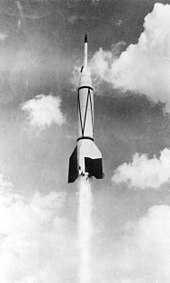
Sounding rockets are commonly used to carry instruments that take readings from 50 kilometers (30 mi) to 1,500 kilometers (930 mi) above the surface of the Earth, the altitudes between those reachable by weather balloons and satellites.[65]
Rocket engines are also used to propel rocket sleds along a rail at extremely high speed. The world record for this is Mach 8.5.[66]
Spaceflight
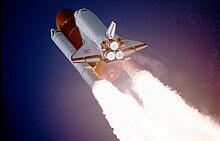
Larger rockets are normally launched from a launch pad which serves as stable support until a few seconds after ignition. Due to their high exhaust velocity - 2,500 to 4,500 m/s (9,000 to 16,000 km/h; 5,600 to 10,000 mph) (Mach ~10+), rockets are particularly useful when very high speeds are required, such as orbital speed (Mach 24+). Spacecraft delivered into orbital trajectories become artificial satellites which are used for many commercial purposes. Indeed, rockets remain the only way to launch spacecraft into orbit and beyond. They are also used to rapidly accelerate spacecraft when they change orbits or de-orbit for landing. Also, a rocket may be used to soften a hard parachute landing immediately before touchdown (see Soyuz spacecraft).
Rescue
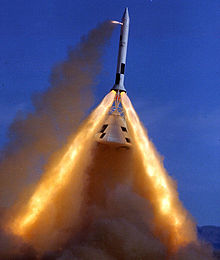
Rockets were used to propel a line to a stricken ship so that a Breeches buoy can be used to rescue those on board. Rockets are also used to launch emergency flares.
Some crewed rockets, notably the Saturn V and Soyuz[70] have launch escape systems. This is a small, usually solid rocket that is capable of pulling the crewed capsule away from the main vehicle towards safety at a moments notice. These types of systems have been operated several times, both in testing and in flight, and operated correctly each time.[citation needed]
Solid rocket propelled ejection seats are used in many military aircraft to propel crew away to safety from a vehicle when flight control is lost.
Hobby, sport and entertainment
Hobbyists build and fly model rockets of various types and rockets are used to launch both commercially available fireworks and professional fireworks displays.
Hydrogen peroxide rockets are used to power jet packs,[72] and have been used to power cars and a rocket car holds the all time (albeit unofficial) drag racing record.[73]
Noise
For all but the very smallest sizes, rocket exhaust compared to other engines is generally very noisy. As the hypersonic exhaust mixes with the ambient air, shock waves are formed. The sound intensity from these shock waves depends on the size of the rocket as well as the exhaust speed. The sound intensity of large, high performance rockets could potentially kill at close range.
The Space Shuttle generates over 200 dB(A) of noise around its base. A Saturn V launch was detectable on seismometers a considerable distance from the launch site.
Noise is generally most intense when a rocket is close to the ground, since the noise from the engines radiates up away from the plume, as well as reflecting off the ground. This noise can be reduced somewhat by flame trenches with roofs, by water injection around the plume and by deflecting the plume at an angle.[74]
For crewed rockets various methods are used to reduce the sound intensity for the passengers, and typically the placement of the astronauts far away from the rocket engines helps significantly. For the passengers and crew, when a vehicle goes supersonic the sound cuts off as the sound waves are no longer able to keep up with the vehicle.[74]
Physics
Operation

In all rockets, the exhaust is formed from propellants carried within the rocket before use.Rocket thrust is due to the rocket engine, which propels the rocket forwards by exhausting the propellant rearwards at extremely high speed.

In a closed chamber, the pressures are equal in each direction and no acceleration occurs. If an opening is provided in the bottom of the chamber then the pressure is no longer acting on the missing section. The remaining pressures give a resultant thrust on the side opposite the opening, as well as permitting exhaust to escape. Using a nozzle increases the forces further since the pressure of expanding exhaust also acts on it, multiplying the thrust as a function of the area ratio of the nozzle. As a side effect the pressures act on the exhaust in the opposite direction and accelerate this to very high speeds (according to Newton's Third Law).
If propellant gas is continuously added to the chamber then this disequilibrium of pressures can be maintained for as long as propellant remains.
Due to conservation of momentum the speed of the exhaust of a rocket determines how much momentum increase is created for a given amount of propellant. This is called the rocket's specific impulse.[63] Because a rocket, propellant and exhaust in flight, without any external perturbations, may be considered as a closed system, the total momentum is always constant. Therefore, the faster the net speed of the exhaust in one direction, the greater the speed of the rocket can achieve in the opposite direction, especially since the rocket mass is typically far lower than the final total exhaust mass.
As the remaining propellant decreases, rocket vehicles become lighter and their acceleration per unit of propellant tends to increase until the propellant is exhausted. This means that much of the speed change occurs towards the end of the burn when the vehicle is much lighter.
Forces on a rocket in flight

The general study of the forces on a rocket or other spacecraft is part of ballistics and is called astrodynamics.
Flying rockets are primarily affected by the following:
- Thrust from the engine(s)
- Gravity from celestial bodies
- Drag if moving in atmosphere
- Lift; usually relatively small effect except for rocket-powered aircraft
In addition, the inertia and centrifugal pseudo-force can be significant due to the path of the rocket around the center of a celestial body; when high enough speeds in the right direction and altitude are achieved a stable orbit or escape velocity is obtained.
These forces, with a stabilizing tail (the empennage) present will, unless deliberate control efforts are made, naturally cause the vehicle to follow a roughly parabolic trajectory termed a gravity turn, and this trajectory is often used at least during the initial part of a launch. (This is true even if the rocket engine is mounted at the nose.) Vehicles can thus maintain low or even zero angle of attack which minimizes transverse stress on the launch vehicle; permitting a weaker, and hence lighter, launch vehicle.
Net thrust

• Underexpanded (above ambient).
• Ambient.
• Overexpanded (below ambient).
• Grossly overexpanded.
If under or overexpanded then loss of efficiency occurs, grossly overexpanded nozzles lose less efficiency, but the exhaust jet is usually unstable. Rockets become progressively more underexpanded as they gain altitude. Note that almost all rocket engines will be momentarily grossly overexpanded during startup in an atmosphere.
A typical rocket engine can handle a significant fraction of its own mass in propellant each second, with the propellant leaving the nozzle at several kilometres per second. This means that the thrust-to-weight ratio of a rocket engine, and often the entire vehicle can be very high, in extreme cases over 100. This compares with other jet propulsion engines that can exceed 5 for some of the better engines.
The propellant flow rate of a rocket is often deliberately varied over a flight, to provide a way to control the thrust and thus the airspeed of the vehicle. This, for example, allows minimization of aerodynamic lossesand can limit the increase of g-forces due to the reduction in propellant load.
It can be shown that the net thrust of a rocket is:
 [82]
[82]
where:
 propellant flow (kg/s or lb/s)
propellant flow (kg/s or lb/s)
 the effective exhaust velocity (m/s or ft/s)
the effective exhaust velocity (m/s or ft/s)
The ve of a rocket engine is often almost constant in a vacuum, but in practice the effective exhaust velocity of rocket engines goes down when operated within an atmosphere as the atmospheric pressure goes up. In space, the effective exhaust velocity is equal to the actual exhaust velocity. In the atmosphere, the two velocities are close in value.
Impulse
The total impulse of a rocket burning its propellant is simply:[83]
When there is fixed thrust, this is simply:
Specific impulse
As can be seen from the thrust equation the effective speed of the exhaust controls the amount of thrust produced from a particular quantity of fuel burnt per second.
An equivalent measure, the net thrust-seconds (impulse) per weight unit of propellant expelled is called specific Impulse "Isp" and this is one of the most important figures that describes a rocket's performance. It is defined such that it is related to the effective exhaust velocity by:
where:
- Isp has units of seconds
- g0 is the acceleration at the surface of the Earth
Thus, the greater the specific impulse, the greater the net thrust and performance of the engine. Isp is determined by measurement while testing the engine. In practice the effective exhaust velocities of rockets varies but can be extremely high, ~4500 m/s, about 15 times the sea level speed of sound in air.
- Typical performances of common propellants
| Propellant mix | Vacuum Isp (seconds) | Effective exhaust velocity (m/s) |
|---|---|---|
| liquid oxygen/ liquid hydrogen | 455 | 4462 |
| liquid oxygen/ kerosene (RP-1) | 358 | 3510 |
| nitrogen tetroxide/ hydrazine | 305 | 2993 |
n.b. All performances at a nozzle expansion ratio of 40
Delta-v (rocket equation)

The delta-v capacity of a rocket is the theoretical total change in velocity that a rocket can achieve without any external interference (without air drag or gravity or other forces).
When ve is constant, the delta-v that a rocket vehicle can provide can be calculated from the Tsiolkovsky rocket equation:
where:
- m0 is the initial total mass, including propellant, in kg (or lb)
- m1 is the final total mass in kg (or lb)
- ve is the effective exhaust velocity in m/s or (ft/s)
 is the delta-v in m/s (or ft/s)
is the delta-v in m/s (or ft/s)
When launched from the Earth practical delta-v's for a single rockets carrying payloads can be a few km/s. Some theoretical designs have rockets with delta-v's over 9 km/s.
The required delta-v can also be calculated for a particular manoeuvre; for example the delta-v to launch from the surface of the Earth to Low earth orbit is about 9.7 km/s, which leaves the vehicle with a sideways speed of about 7.8 km/s at an altitude of around 200 km. In this manoeuvre about 1.9 km/s is lost in air drag, gravity drag and gaining altitude.
The ratio  is sometimes called the mass ratio.
is sometimes called the mass ratio.
Mass ratios

Persons not familiar with spaceflight rarely realize that almost all of a launch vehicle's mass consists of propellant. Mass ratio is, for any 'burn', the ratio between the rocket's initial mass and the mass after. Everything else being equal, a high mass ratio is desirable for good performance, since it indicates that the rocket is lightweight and hence performs better, for essentially the same reasons that low weight is desirable in sports cars.
Rockets as a group have the highest thrust-to-weight ratio of any type of engine; and this helps vehicles achieve high mass ratios, which improves the performance of flights. The higher the ratio, the less engine mass is needed to be carried. This permits the carrying of even more propellant, enormously improving the delta-v. Alternatively, some rockets such as for rescue scenarios or racing carry relatively little propellant and payload and thus need only a lightweight structure and instead achieve high accelerations. For example, the Soyuz escape system can produce 20g
Achievable mass ratios are highly dependent on many factors such as propellant type, the design of engine the vehicle uses, structural safety margins and construction techniques.
The highest mass ratios are generally achieved with liquid rockets, and these types are usually used for orbital launch vehicles, a situation which calls for a high delta-v. Liquid propellants generally have densities similar to water (with the notable exceptions of liquid hydrogen and liquid methane), and these types are able to use lightweight, low pressure tanks and typically run high-performance turbopumps to force the propellant into the combustion chamber.
Some notable mass fractions are found in the following table (some aircraft are included for comparison purposes):
| Vehicle | Takeoff Mass | Final Mass | Mass ratio | Payload fraction |
|---|---|---|---|---|
| Ariane 5 (vehicle + payload) | 746,000 kg (~1,645,000 lb) | 2,700 kg + 16,000 kg(~6,000 lb + ~35,300 lb) | 39.9 | 0.975 |
| Titan 23G first stage | 117,020 kg (258,000 lb) | 4,760 kg (10,500 lb) | 24.6 | 0.959 |
| Saturn V | 3,038,500 kg(~6,700,000 lb) | 13,300 kg + 118,000 kg(~29,320 lb + ~260,150 lb) | 23.1 | 0.957 |
| Space Shuttle (vehicle + payload) | 2,040,000 kg (~4,500,000 lb) | 104,000 kg + 28,800 kg (~230,000 lb + ~63,500 lb) | 15.4 | 0.935 |
| Saturn 1B (stage only) | 448,648 kg(989,100 lb) | 41,594 kg(91,700 lb) | 10.7 | 0.907 |
| Virgin Atlantic GlobalFlyer | 10,024.39 kg (22,100 lb) | 1,678.3 kg (3,700 lb) | 6.0 | 0.83 |
| V2 | 13,000 kg (~28,660 lb) (12.8 ton) | 3.85 | 0.74 | |
| X-15 | 15,420 kg (34,000 lb) | 6,620 kg (14,600 lb) | 2.3 | 0.5 |
| Concorde | ~181,000 kg (400,000 lb | 2 | 0.5 | |
| Boeing 747 | ~363,000 kg (800,000 lb | 2 | 0.5 |
Staging
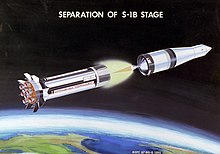

Often, the required velocity (delta-v) for a mission is unattainable by any single rocket because the propellant, tankage, structure, guidance, valves and engines and so on, take a particular minimum percentage of take-off mass that is too great for the propellant it carries to achieve that delta-v.
For example the first stage of the Saturn V, carrying the weight of the upper stages, was able to achieve a mass ratio of about 10, and achieved a specific impulse of 263 seconds. This gives a delta-v of around 5.9 km/s whereas around 9.4 km/s delta-v is needed to achieve orbit with all losses allowed for.
This problem is frequently solved by staging — the rocket sheds excess weight (usually empty tankage and associated engines) during launch. Staging is either serial where the rockets light after the previous stage has fallen away, or parallel, where rockets are burning together and then detach when they burn out.
The maximum speeds that can be achieved with staging is theoretically limited only by the speed of light. However the payload that can be carried goes down geometrically with each extra stage needed, while the additional delta-v for each stage is simply additive.
Acceleration and thrust-to-weight ratio
From Newton's second law the acceleration of a vehicle is simply:
Where m is the instantaneous mass of the vehicle and Fn is the net force acting on the rocket (mostly thrust but air drag and other forces can play a part.)
Typically, the acceleration of a rocket increases with time (if the thrust stays the same) as the weight of the rocket decreases as propellant is burned, but the thrust can be throttled to offset or vary this if needed. Discontinuities in acceleration will also occur when stages burn out, often starting at a lower acceleration with each new stage firing.
Peak accelerations can be increased by designing the vehicle with a reduced mass, usually achieved by a reduction in the fuel load and tankage and associated structures, but obviously this reduces range, final speed and burn time. Still, for some applications that rockets are used for, a high peak acceleration applied for just a short time is highly desirable.
The minimal mass of vehicle consists of a rocket engine with minimal fuel and structure to carry it. In that case the thrust-to-weight ratio[nb 4] of the rocket engine limits the maximum acceleration that can be designed. It turns out that rocket engines generally have truly excellent thrust to weight ratios (137 for the NK-33 engine, some solid rockets are over 1000), and nearly all really high-g vehicles employ or have employed rockets.
The high accelerations that rockets naturally possess means that rocket vehicles are often capable of vertical takeoff; this can be done provided the vehicles engines provide more than the local gravitational acceleration away from the Earth or gravity source.
Drag
Drag is a force which acts opposite to the direction of the rocket's motion. This will cause a decrease in the acceleration of the vehicle whilst also producing structural loads.
Drag can be minimised by an aerodynamic nose cone and by using a shape with a high ballistic coefficient (the "classic" rocket shape - long and thin).
During a rocket launch, as the vehicle speed increases, and the atmosphere thins, there is a point of maximum aerodynamic drag called Max Q. This determines the minimum aerodynamic strength of the vehicle, as the rocket must avoid buckling under these forces.
Energy efficiency

Rocket launch vehicles take-off with a great deal of flames, noise and drama, and it might seem obvious that they are grievously inefficient. However, while they are far from perfect, their energy efficiency is not as bad as might be supposed.
The energy density of a typical rocket propellant is often around one-third that of conventional hydrocarbon fuels; the bulk of the mass is (often relatively inexpensive) oxidizer. Nevertheless, at take-off the rocket has a great deal of energy in the fuel and oxidizer stored within the vehicle. It is of course desirable that as much of the energy of the propellant end up as kinetic or potential energy of the body of the rocket as possible.
Energy from the fuel is lost in air drag and gravity drag and is used for the rocket to gain altitude and speed. However, much of the lost energy ends up in the exhaust.
100% efficiency within the engine (engine efficiency ηc = 100%) would mean that all the heat energy of the combustion products is converted into kinetic energy of the jet. This is not possible, but the high expansion ratio nozzles that can be used with rockets come surprisingly close: when the nozzle expands the gas, the gas is cooled and accelerated, and an energy efficiency of up to 70% can be achieved. Most of the rest is heat energy in the exhaust that is not recovered.The high efficiency is a consequence of the fact that rocket combustion can be performed at vry high temperatures and the gas is finally released at much lower temperatures, and so giving good Carnot efficiency.
However, engine efficiency is not the whole story. In common with the other jet-based engines, but particularly in rockets due to their high and typically fixed exhaust speeds, rocket vehicles are extremely inefficient at low speeds irrespective of the engine efficiency. The problem is that at low speeds, the exhaust carries away a huge amount of kinetic energy rearward. This phenomenon is termed propulsive efficiency (ηp).
However, as speeds rise, the resultant exhaust speed goes down, and the overall vehicle energetic efficiency rises, reaching a peak of around 100% of the engine efficiency when the vehicle is travelling exactly at the same speed that the exhaust is emitted. In this case the exhaust would ideally stop dead in space behind the moving vehicle, taking away zero energy, and from conservation of energy, all the energy would end up in the vehicle. The efficiency then drops off again at even higher speeds as the exhaust ends up travelling forwards- trailing behind the vehicle.
From these principles it can be shown that the propulsive efficiency ηp for a rocket moving at speed u with an exhaust velocity c is:
And the overall energy efficiency η is:
- η = ηpηc
For example, from the equation, with an ηc of 0.7, a rocket flying at Mach 0.85 (which most aircraft cruise at) with an exhaust velocity of Mach 10, would have a predicted overall energy efficiency of 5.9%, whereas a conventional, modern, air breathing jet engine achieves closer to 35% efficiency. Thus a rocket would need about 6x more energy; and allowing for the ~3x lower specific energy of rocket propellant than conventional air fuel, roughly 18x more mass of propellant would need to be carried for the same journey. This is why rockets are rarely if ever used for general aviation
Since the energy ultimately comes from fuel, these considerations mean that rockets are mainly useful when a very high speed is required, such as ICBMs or orbital launch. For example NASA's space shuttle fires its engines for around 8.5 minutes, consuming 1,000 tonnes of solid propellant (containing 16% aluminium) and an additional 2,000,000 litres of liquid propellant (106,261 kg of liquid hydrogen fuel) to lift the 100,000 kg vehicle (including the 25,000 kg payload) to an altitude of 111 km and an orbital velocity of 30,000 km/h. With an energy density of 31MJ per kg for aluminum and 143 MJ/kg for liquid hydrogen, this means that the vehicle consumes around 5 TJ of solid propellant and 15 TJ of hydrogen fuel. Once in orbit at 200 km and around 7.8 km/s velocity, the orbiter requires no further fuel. At this altitude and velocity, the vehicle has a kinetic energy of about 3 TJ and a potential energy of roughly 200 GJ. Given the initial energy of 20 TJ, the Space Shuttle is about 16% energy efficient at launching the orbiter.
Thus jet engines which have a better match between speed and jet exhaust speed such as turbofans (in spite of their worse ηc) dominate for subsonic and supersonic atmospheric use while rockets work best at hypersonic speeds. On the other hand rockets do also see many short-range relatively low speed military applications where their low-speed inefficiency is outweighed by their extremely high thrust and hence high accelerations.
Oberth effect
One subtle feature of rockets relates to energy. A rocket stage, while carrying a given load, is capable of giving a particular delta-v. This delta-v means that the speed will increase (or decrease) by a particular amount. However, because kinetic energy is a square law on speed, this means that the faster the rocket is travelling before the burn the more energy it gains or loses.
This fact is used in interplanetary travel, since the amount of delta-v to reach other planets, over and above that to reach escape velocity is fairly modest if it is applied close to the Earth or other planetary surface at high speeds, whereas waiting till the rocket has slowed down at altitude multiplies up the burn required to gain any particular required energy and trajectory.
Safety, reliability and accidents
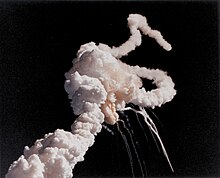
Rockets are not inherently highly dangerous. In military use, adequate reliability and safety is obtained. However, for space use, most flights have some risk.Richard Feynmann estimated that the chance of an unsafe condition for a launch of the Shuttle was very roughly 1%, and the historical per person-flight risk in orbital spaceflight is around 1 in 50.
Because of the enormous chemical energy in useful rocket propellants (greater energy by weight than explosives, but lower than gasoline), accidents can, have, and will happen. The number of people injured or killed is usually small because of the great care normally taken, but their record is not perfect.
Rockets are also used to improve safety- many ejection seats are essentially rockets that can propel pilots very quickly away from their aircraft, and they have saved many lives. Similar systems are in place on many manned rocket vehicles.
Costs and economics
The costs of rockets can be roughly divided into propellant costs, the costs of obtaining and/or producing the 'dry mass' of the rocket and the costs of any required support equipment and facilities.
Most of the takeoff mass of a rocket is normally propellant. However propellant is seldom more than a few times more expensive than gasoline per kg (as of 2009 gasoline is about $1/kg or less), and although substantial amounts are needed, for all but the very cheapest rockets it turns out that the propellant costs are usually comparatively small, although not completely negligible.
The costs of the dry mass of the rocket depend largely on the manufacturing processes needed to shape and assemble it; the materials used are rarely expensive in and of themselves. For complete aerospace materials average costs of ~$10,000/kg (as of 2009) are common. This high cost is largely due to the work force and equipment needed to form lightweight structures that perform well in rockets. Even though the dry mass of the rocket is usually a small fraction of the rocket (often between and 1/40 of the rocket), nevertheless this cost dominates.
However the structure of simple rockets that are produced in large quantities can be many times cheaper, while very high performance, complex structures that are produced in small quantities tend to be more expensive, although give more performance.
The costs of support equipment, range costs and launch pads generally scale up with the size of the rocket, but vary less with launch rate, and so may be considered to be approximately a fixed cost.









0 comments:
Post a Comment